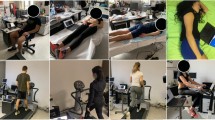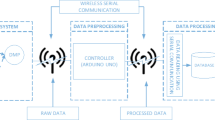Abstract
Recently, many researchers have proposed a number of respiratory monitoring methods to monitor the respiratory amplitude and respiratory rate of athletes under different conditions. However, the problem with such methods is that their accuracy is not high. Therefore, this paper proposes a respiratory monitoring method based on a BP neural network combined with multisensor fusion technology. First, we fix multiple sensors on the chest and back of the human body so that we can accurately measure the acceleration and angular velocity changes caused by the contraction and expansion of the chest contour when athletes breathe under different motion conditions. After a coordinate measurement is performed on the data measured by the back measurement unit, the BP network algorithm is used to obtain the acceleration curve under the simple respiratory motion state. Finally, the respiratory frequency and respiratory depth parameters, which are important indicators for evaluating athletes’ physical fitness, can be obtained for the athletes under different motion states. Verification was carried out in an experimental platform, and the experimental results for different postures of the human body were compared with the standard respiratory mask measurement results. The accuracy rate was over 90%, thus realizing the networking, portability, and wearability of the breathing state sensors, which provide real-time accurate measurements.











Similar content being viewed by others
References
Liyuan Z (2017) Detection and evaluation of biochemical indexes of physical function of track and field athletes. Sports Sci Technol 38(5):30–31
Jarchi D, Rodgers SJ, Tarassenko L et al (2018) Accelerometry based estimation of respiratory rate for post-intensive care patient monitoring. IEEE Sens J 18(2):4981–4989
Lianwang Hao, Tao Song (2007) Study on the detection method of respiratory signal. Micronanoelectronics Z1:12–16
Cao R, Wang JN, Zhao SY et al (2018) Self-powered nanofiber-based screen-print triboelectric sensors for respiratory monitoring. Nano Res 11(7):3771–3779
Ying Ma, Yunfeng Wang, Haiying Zhang (2018) Real-time monitoring of heart rate and respiratory rate based on piezoelectric thin film sensor. Sens Microsyst 6:124–126
Patonis P, Patias P, Tziavos IN et al (2018) A fusion method for combining low-cost IMU/magnetometer outputs for use in applications on mobile devices. Sensors 18:2616(1–18)
Liu K, Wu WQ, Tang KH et al (2018) IMU signal generator based on dual quaternion interpolation for integration simulation. Sensors 18:2721(1–18)
Zhang Y, Li Y, Su J (2019) Iterative learning control for singular distributed parameter system. Neural Comput Appl 31(9):4503–4512
Yang H, Li W, Luo CM (2015) Fuzzy adaptive Kalman filter for indoor mobile target positioning with INS/WSN integrated method. J Cent South Univ 22(4):1324–1333
Fang XQ, Zhao JJ, Hu Y (2010) Tests and error analysis of a self-positioning shearer operating at aimless working face. Min Sci Technol 20(1):53–58
Bastas G, Fleck JJ, Peters RA et al (2018) IMU-based gait analysis in lower limb prosthesis users: comparison of step demarcation algorithms. Gait Posture 64:30
Alam MN, Khan Munia TT, Fazel-Rezai R (2017) Gait speed estimation using Kalman filtering on inertial measurement unit data. In: International Conference of the IEEE Engineering in Medicine & Biology Society, p 2406
Zhang Y, Li Y, Su J (2018) Iterative learning control for image feature extraction with multiple-image blends. EURASIP J Image Video Process 100:1–11
Zhuangsheng Zhu, Yulong Zhang, Chi Li (2017) Multi-source information adaptive step detection method based on the inertial measurement unit of the MEMS. Chin J Inert Technol 25(3):299–303
Xuemei Wang, Zhen Liu, Wenbo Ni (2017) Measurement and recognition of arm motion based on micro-electro-mechanical sensors. Chin J Inert Technol 25(6):701–707
Widagdo PAC, Lee HH, Kuo CH (2017) Limb motion tracking with inertial measurement units. In: IEEE International Conference on Systems, Man and Cybernetics, pp 582–587
Hosseinyalamdary S (2018) Deep Kalman filter: simultaneous multi-sensor integration and modeling: a GNSS/IMU case study. Sensors 18:1316(1–15)
Sun W, Ding W, Yan HF et al (2018) Zero velocity interval detection based on continuous hidden Markov model in micro inertial pedestrian navigation. Meas Sci Technol 29(6):065103
Borshch NA, Kurganskii SI (2018) Electronic structure of four-element clathrates of the Ba–Zn–Si–Ge system. Semiconductors 52(3):282–286
Brahem MB, Ménélas BAJ, Otis JD (2013) Use of a 3DOF accelerometer for foot tracking and gesture recognition in mobile HCI. Procedia Comput Sci 19:453–460
Zhang Yinjun (2016) A class of time-delay disturbance discrete system for iterative learning control. ICIC Express Lett B Appl 7(2):357–362
Acknowledgements
The work was supported by the General Project of Humanities and Social Sciences Research of Henan Education Department: The Fitness and Recreation Industry Development Research of Henan Province under the Healthy China Background (No. 2020-ZZJH-469).
Author information
Authors and Affiliations
Corresponding author
Ethics declarations
Conflict of interest
The authors declare that there is no conflict of interest regarding the publication of this paper.
Additional information
Publisher's Note
Springer Nature remains neutral with regard to jurisdictional claims in published maps and institutional affiliations.
Rights and permissions
About this article
Cite this article
Wang, S. Multisensor data fusion of motion monitoring system based on BP neural network. J Supercomput 76, 1642–1656 (2020). https://doi.org/10.1007/s11227-019-03015-0
Published:
Issue Date:
DOI: https://doi.org/10.1007/s11227-019-03015-0




